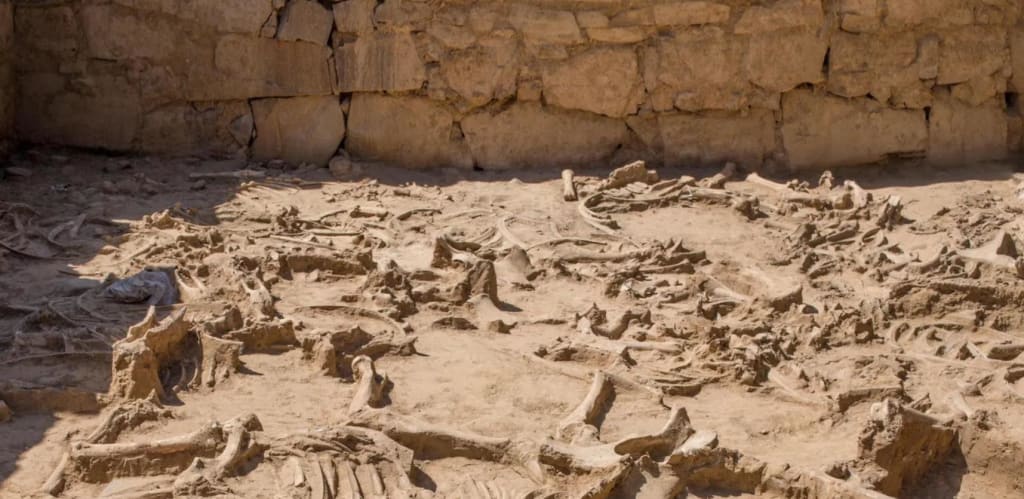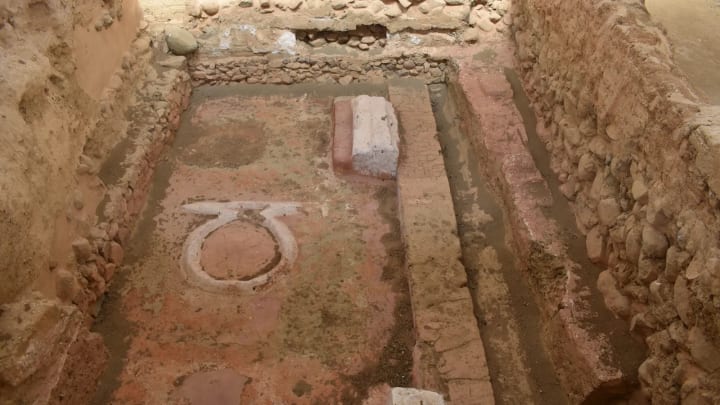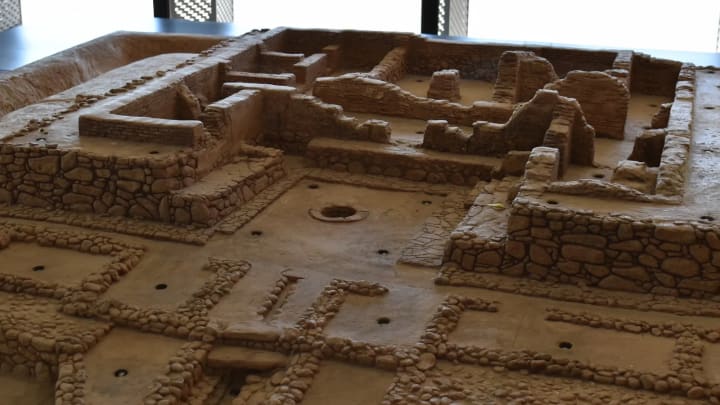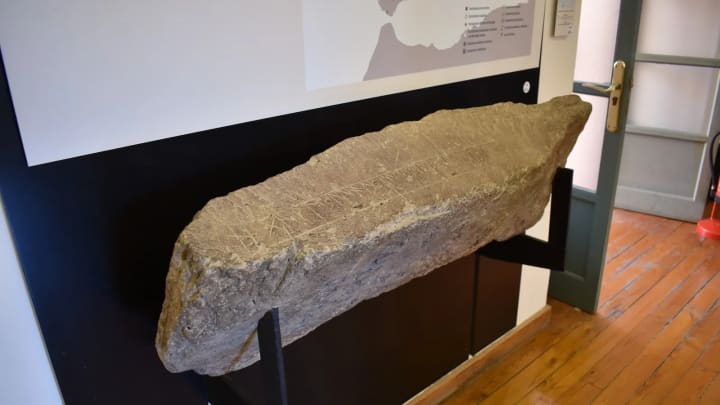
After crunching across a gravel path, surrounded by sun-parched plains, I finally arrived at the Cancho Roano archaeological site. Standing here, in the Guadiana Valley of the Extremadura region in south-western Spain, I imagined how different this dusty and arid flatland would have appeared 2,500 years ago when it was a hub of trade and worship for Tartessos, a mysterious Iberian society that thrived between the 9th and 5th Centuries BCE – and then abruptly disappeared.
Today, though, a culmination of ongoing research and new technology are revealing more about this lost civilisation and the role it played in the history of Iberia.
Going back millennia, Tartessos has been referred to in Greek and Roman texts, but due to conflicting descriptions – and, for a long time, a lack of conclusive archaeological evidence – it has not been easy for modern historians and archaeologists to pinpoint what Tartessos even was – a city, a kingdom, a river?
Herodotus, the Greek historian from the 5th Century BCE, wrote of a harbour city beyond the Pillars of Hercules (modern-day Strait of Gibraltar), which led some researchers to think that Tartessos was a body of water and others to think it was a port (possibly located around modern-day Huelva on Spain's southern coast). There were even theories, inspired by Aristotle's writings, that Tartessos was the mythical Atlantis, although this has been widely dismissed in the scientific community.
Tartessos is now generally considered to be a civilisation that formed from a mixture of indigenous people and Greek and Phoenician colonisers in the Iberian Peninsula. And it was wealthy too, thanks to rich resources of metal and a prosperous trade economy. Early discoveries had led historians to believe that the civilisation was concentrated around Andalucía's Guadalquivir Valley, but more recent finds in the Guadiana Valley – farther west near Spain's border with Portugal – have made archaeologists rethink how expansive Tartessos was. In total, more than 20 Tartessos sites have been identified across Spain, and three have been excavated in the Guadiana Valley: Cancho Roano, Casas de Turuñuelo and La Mata.

Archaeologists uncovered Cancho Roano in 1978, and it revealed yet another piece of the story. The site contains the remnants of three Tartessian temples that were built in succession, each on the ruins of the previous, all of them orientated toward sunrise. An interpretation centre explains what's known of the history of the temples and the artefacts that were found inside.
The adobe walls of the most recent temple (constructed around the end of the 6th Century BCE) outline 11 rooms and span an area of around 500 sq m. But for reasons that archaeologists have not yet deciphered, at the end of the 5th Century BCE, the people living here conducted a ritual in which they ate animals, discarded the remains in a central pit, set the temple on fire, sealed it with clay and then abandoned it all – leaving a host of objects to burn inside, such as iron tools and gold jewellery.
"The discovery of Cancho Roano was a revolution in the archaeology of the Iberian Peninsula," said Sebastián Celestino Pérez, who was director during the 23-year excavation and is now a scientific investigator at the Institute of Archaeology in Merida. He explained that not only were the site's walls, altar, moat and artefacts (such as jewellery, glasses and a warrior stele) well-preserved despite the fire, but many scientists didn't believe such a place could be found outside of Andalucía, where all previous evidence had been unearthed.

Casas de Turuñuelo, which has only been studied in the past few years (it was found in 2015), is the best preserved protohistoric building in the western Mediterranean and the site of the largest animal sacrifice in the area – more than 50 animals – which is helping scientists understand more about the Tartessian culture.
"Turuñuelo [was] a sanctuary where a sacrifice of animals was also practiced and they were then thrown into the pit," said Celestino Perez, noting that this site was also burned down and sealed with clay in the same manner as Cancho Roano. "But Turuñuelo has another functionality, more ostentatious – it is like a symbol of power. It is contemporary to Cancho Roano, but nevertheless the construction techniques used at Turuñuelo are much more advanced and the materials of greater richness and brought from many points of the Mediterranean."
Using a new technology called photogrammetry, archaeologists are taking photographs of the ruins at Turuñuelo, and then using software to blend them and create 3D images that virtually reconstruct the buildings. The process helps them understand the construction types and techniques and the raw materials used – and as a result, the ruins at Turuñuelo are now known to be Tartessian, rather than Roman as previously thought.

The La Mata site was found much earlier than the other two (in 1930), but it has striking similarities – and the approach now being used at Turuñuelo could unlock more of its secrets. "The most surprising thing for me is the very peculiar habit [the Tartessos] had of destroying their homes, that is, in all the sites found, the same behaviour has been followed: emptying all the vessels and amphorae, burning the building and burying it," said Ana Belén Gallardo Delgado, a historian and guide at La Mata.
"With the new technologies, I hope that much more can be clarified about the origin of this civilisation and delve a little more into its way of life. The Tartessian presence in the Extremadura area is becoming more and more important thanks to new advances in archaeology. Also, it is believed that another eight burial mounds found in the Badajoz area could be Tartessian buildings like those already excavated," she said.

While research continues at the Extremaduran sites (Cancho Roano and La Mata are open to the public), history buffs can also view recovered Tartessian tools, horse statuettes and decorated ivory at the Archaeological Museum of Badajoz. It's located inside the Alcazaba, a 12th-Century Moorish citadel perched atop a hill and surrounded by well-kept gardens close to the Portuguese border. As I browsed a gallery dedicated to the Spanish protohistoric period, museum attendant Celia Lozano Soto pointed out a stele engraved with Tartessian inscriptions, the first example of writing in the Iberian Peninsula.
"The language is still being studied and translated now," she said, "it's a mixture of different things which make it unique in this respect."
A curious, palindromic script from around the 8th Century BCE, this writing stems from the Phoenician alphabet. It can be read from right to left or vice versa, although the sounds represented by each symbol are still uncertain.
In addition to the language, mass sacrifices and fires, the other big enigma of Tartessos is why it abruptly vanished about 2,500 years ago.

Eduardo Ferrer-Albelda, professor of archaeology at the University of Seville, pointed out that since the Tartessian society was rich in metals, any slow-down in trade could have ramped up tensions. "A crisis in mining is also documented, but violence had to play an important role," he explained. "The collusion between the Phoenician and indigenous aristocracies could have ended abruptly, so that an anti-Phoenician and anti-aristocratic movement can be assumed among the populations of the Tartessian area."
Celestino Perez espoused another theory. "The most current thing is that it seems that there could have been an earthquake in the middle of the 6th Century BCE, followed by a tsunami that could have affected the main Tartessian ports, and that would be the cause of the rapid fall of Tartessos," he said.
While understanding why the civilisation disappeared is important, the social and cultural impact of the Tartessos is the focus of current research.
As Celestino Perez explained, "What seems to be the Tartessian port of Huelva has been located. If confirmed, it could be a giant step to understanding the Tartessian trade network. And the so-called Tartessian tombs of the Guadiana [Cancho Roana, Turuñuelo and La Mata] seem to have the key to know this culture better."
About the Creator
Haas Tash
No need for deliberate pandering.






Comments
There are no comments for this story
Be the first to respond and start the conversation.